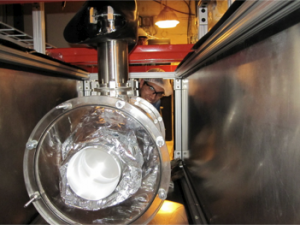DEAP-1 was a prototype detector for DEAP-3600. Constructed and first run at Queen’s University from 2006-2007, it was moved to SNOLAB at the end of 2007 and further run from 2007-2011. The main purpose of DEAP-1 was to demonstrate the power of pulse shape discrimination (PSD) better than 2.8X10-8 keVee for the suppression of background interference when attempting to detect dark matter using liquid argon.
In rare event search experiments like DEAP, all possible backgrounds have to be understood and dealt with by either eliminating them or showing that they will not mimic a Weakly Interacting Massive Particle (WIMP) signal. The following sources of background need to be addressed in DEAP: By far the largest background will be β particles from the decay of 39Ar, which is produced cosmogenically and decays at a rate of about 1 Bq per kg of argon. This background, as well as any γ radiation, can be very effectively mitigated by PSD. Sources of argon depleted in 39Ar are also being explored. A more dangerous background are neutrons, which mimic the expected WIMP signal in the PSD parameter Fprompt and in energy. DEAP-1 detector was surrounded by a minimum of two layers of ultra-pure water in 12-inch cubical polyethylene containers for a total water shielding thickness of 60 cm to stop neutrons on their way to the detector.
The core of DEAP-1 contains a 7 kg liquid argon target in a low background cryostat, viewed by two 5-inch photomultiplier tubes (PMTs) at room temperature for detection of the scintillation light through acrylic light guides. The inner detector in contact with argon is acrylic, and is coated with tetraphenyl butadiene (TPB) for conversion of the UV scintillation light to visible light.
Recoiling nuclei or electrons will generate scintillation light in liquid argon allowing those interactions to be detected. Dimers in liquid argon are created in either singlet or triplet states, leading to short (few nanoseconds) and long (1.5 microseconds) time constants. The fraction of singlet to triplet states is different for nuclear and electron recoils, and allows for PSD.


